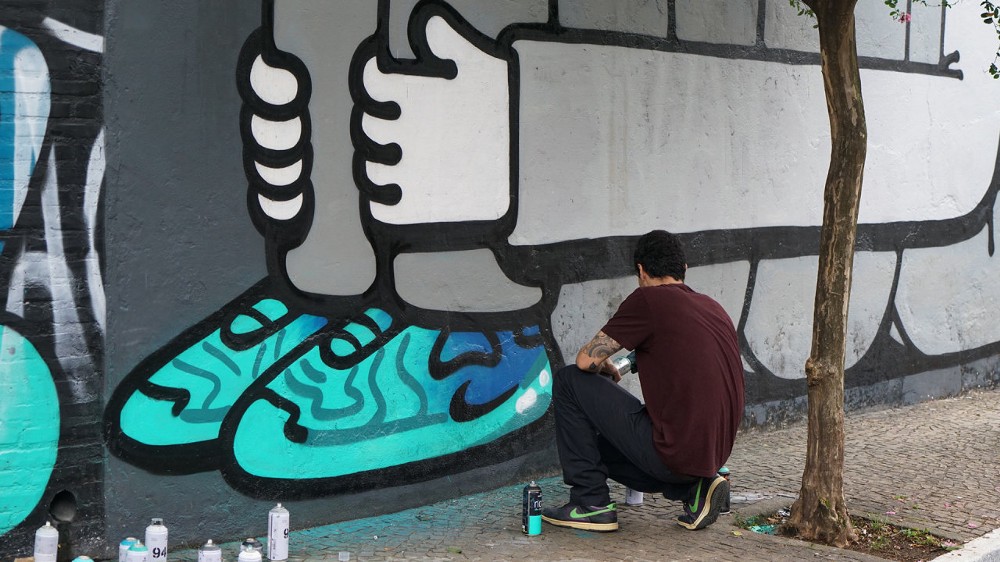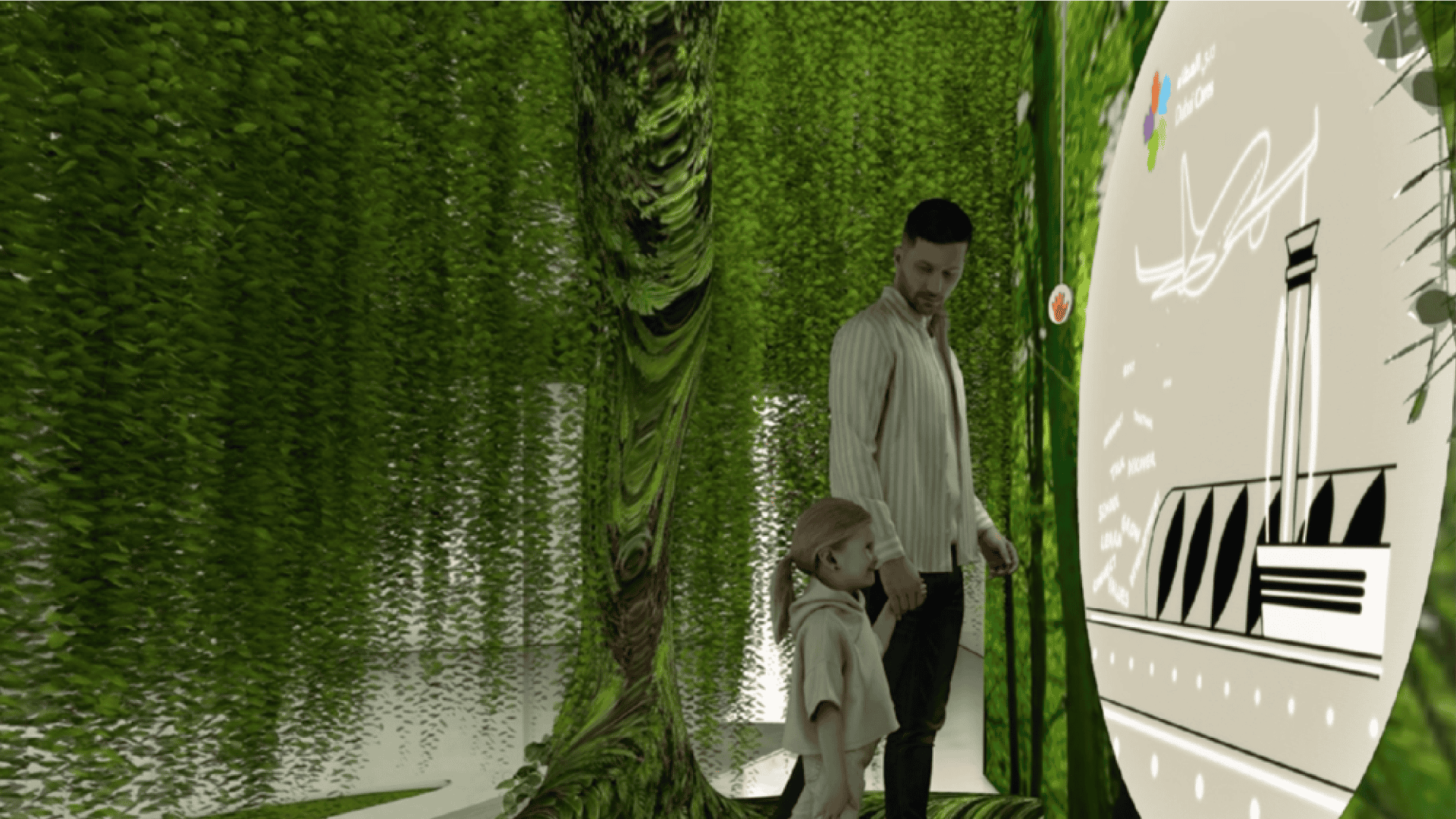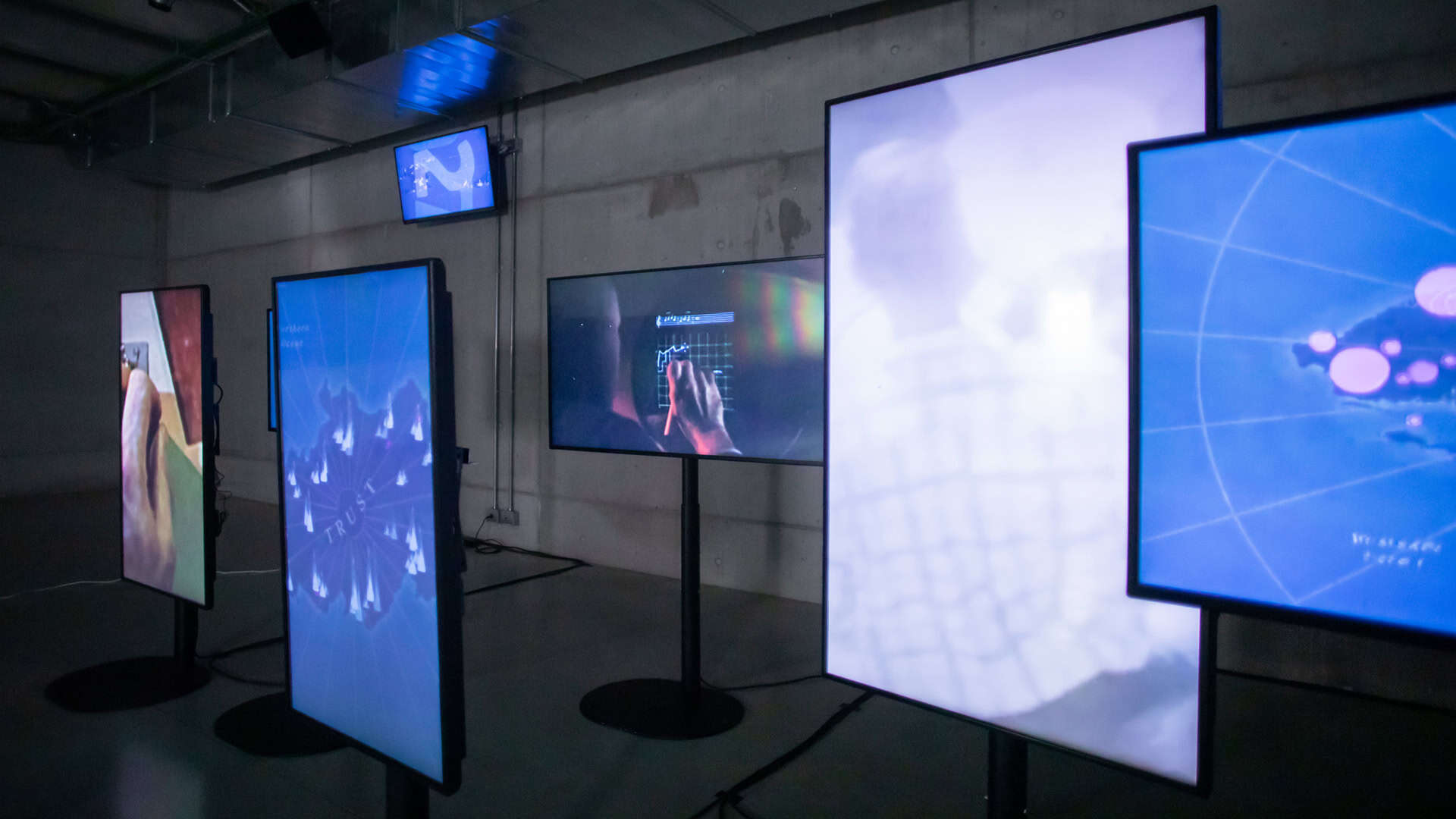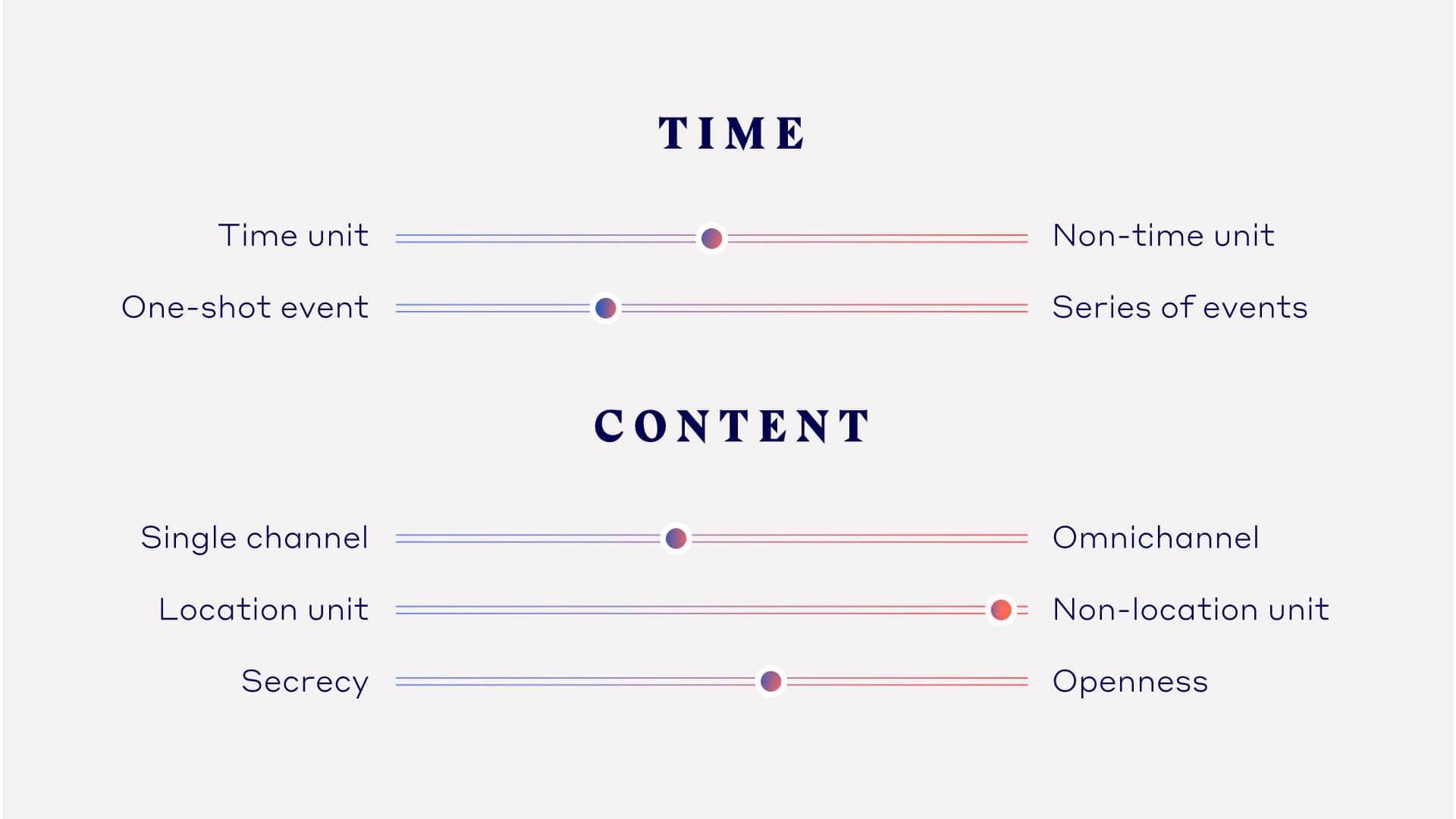Immersive experiences
Moreno Callegari
Senior, content designer
Brand experiences
2021

How brands can create transformative, memorable experiences for their audiences
In our job, what has happened has led us to rethink many of the things we do. We started to think about how immersive experiences, particularly those with a high cultural and artistic value, have changed and will keep on changing, and thus the way we want to relate to those changes.
The world of physical experiences has virtually stopped overnight in 2020, and it is going to be hard for many traditional venues to reprise in the coming months.
Much like any other experience provider, we have had to ask ourselves what concepts like “immersiveness” actually mean, and how to recreate that feeling without a shared physical space.
Immersive Experience Design
The value of the Experience Economy has been known for some time now: we moved from a product-based to a service-based economy, and subsequently focused on an approach that intimately values experiences — albeit with a bit of a rocky start.
“…in a world saturated with largely undifferentiated goods and services, the greatest opportunity for value creation resides in staging experiences.”
At MAIZE, we have long worked on creating immersive experiences based on the brands’ values.
Since this is a rather huge research field (we refer to Pine and Gilmore’s 1999 The Experience Economy, republished in 2011), we want to focus on our point of view here: What is an immersive experience for us, and how can it add value to a brand?
2020 has brought us some much-needed advice, and allowed us to think this topic through: from the organization of high added cultural value, immersive physical experiences to a complete rethinking of said experiences through a virtual lens; from reflections on offline and offline events to entirely digital events (both for our clients and our own 100% virtual maize.LIVE).
We feel we have come to thoughtful, insightful conclusions, which from now on we will refer to as Immersive Experience Design.
Let’s build authentic experiences for brands
If by “experience” we mean an event or an occurrence that leaves a lasting impression on someone, when we add the adjective “immersive” we want to insist on the role that the public plays on the experience; the importance of their choices, and how central the transformation of the user is as the ultimate goal of the experience itself.
When we talk about immersive experiences promoted by a brand, we, first of all, mean the creation of a dimension in which the brand is not necessarily at the center, but rather behind the scenes: promoting and curating a transformative journey for the user, searching for a new world.

Giandomenico Tiepolo, Il Mondo Nuovo, 1791, fresco, Ca’ Rezzonico (Venice). An indistinct crowd of spectators waiting for their turn and thronging one another in a mysterious spectacle.
Immersive experiences bring the user (the consumer, the employee, etc.) behind a new dimension; one of discovery and wonder, aligned with the company’s value and the story it wants to tell.
Our approach aims at creating a space where brands are allowed to express those values, concepts, alternative worlds, and, more generally speaking, their vision of things. In an era where brands are increasingly important points of reference for the younger generations, their need to put out a manifesto that says who they are and what they stand for is veritably heightened.
Brands need a charter of values to create a new and previously unknown experimental space, where it’s possible to observe people interacting, searching, being moved, facing their fears, growing, changing. It follows that such space can also become an opportunity for companies to know and study what users want or look for and how they react, other than being an opportunity to practically visualize a scenario and share it.
“…this generation not only highly values experiences, but they are increasingly spending time and money on them: from concerts and social events to athletic pursuits, to cultural experiences and events of all kinds. For this group, happiness isn’t as focused on possessions or career status. Living a meaningful, happy life is about creating, sharing, and capturing memories earned through experiences that span the spectrum of life’s opportunities.”
Types of immersive experiences
An experience, much like a theatrical performance, needs a mise-en-scene. Its nature doesn’t really have to do with the tangible or intangible (i.e. what is online or offline), but mostly with how memorable it is.
According to Daniel Kahneman, Nobel Prize winner and founder of Behavioural economics, there is a difference between the experience itself and the way we remember it. The so-called “experiencing self” only knows the present moment, while the “remembering self” is a storyteller, who uses memories, sounds, smells, and tactile feedback to recreate a new experience enhanced by their mind.
“Odd as it may seem, I am my remembering self, and the experiencing self, who does my living, is like a stranger to me.”
This is why it’s crucial that each experience accurately design the elements that will make it memorable.
So if an immersive experience manages to create an emotional space (in which the user can access by striking a deal, so to speak, as they do in front of any artistic product), how will this space look like, and with what features?
It might be:
- the rethinking of a real space seeking to tell a new story;
- something that emulates reality — for instance, it might use AR or VR technologies to let users live a full experience despite the presence of a pre-established space;
- the mise-en-scene of a possible future scenario (Future Envisioning).

For a client in the luxury business, we have organized an immersive experience inside an English mansion to allow the public to come into contact with the history and the contents of the location.

For a product launch, Nike and AKQA have asked a number of artists to paint Air Max shoes on some iconic São Paulo walls, transforming the purchasing experience into an immersive one.

The Faroe Islands have had an original idea to face the pandemic-induced crisis. Like inside a video game, the user can remotely control the movements of a true islander in the exploration of the island.

In this particular moment in history, where people’s mobility is severely limited, virtual visits have become even more relevant when thinking about the role of cultural places. Museums, libraries, and foundations all around the world have given visitors access to their spaces in an alternative way, mostly as virtual guided tours, videos, podcasts to give curators a voice, temporary exhibitions, or site-specific events.

Sensorium is an interactive exhibition with six installations that we have made for Gucci’s Milan Hub for Fast Company’s “The Dawn of AI” event. Its main goal was to explore the aspects that distinguish the man from the machine, and to guide participants in the discovery of human senses and emotions by using advanced technologies to amplify or measure emotions.

For Dubai’s 2020 Expo, we created a couple of concepts for a pavilion whose goal was to make visitors understand education’s central role and its transformative potential. A green, immersive space where the natural course of growth is narrated through a series of installations, projections, and interactive experiences designed to stimulate emotions, engage with the senses, create awareness, and open the mind towards new opportunities.

What is innovation, if not the chasing of something that doesn’t yet exist? December 2020: From a physical event, maize.LIVE transforms itself into a new kind of virtual experience. For three consecutive afternoons, we “invaded” the screens of hundreds of participants, exploring the concepts of time, loyalty, and happiness together with international guests. During the live panels, we have let the conversation flow through with the audience’s questions, conveniently provoked by written prompts that were read (and interpreted) by our staff, used to make the most common cliches associated with innovation emerge.
We created several kinds of experiences (both physical and digital), and we can now define some cornerstones.
Public, curator, content
For starters, to even exist, an experience needs time and space, whose combination creates a dimension. The experience can happen in a real or a virtual dimension.
Each of these dimensions has some peculiar characteristics that the others don’t — for instance, only the virtual dimension can offer elements such as an omnichannel. At the same time, both necessitate to be consistent with the brand identity, and need to be memorable to the user.
Space and time lead to tensions that are necessary to define to create an experience: Does it need a time unit? A space unit? Is it a serialized experience, or is it a one-shot affair?

An example of tensions we need to evaluate to organize an experience.
Then we need to define some basic elements, such as:
- the audience
- the curator (a.k.a. the Master of Ceremony)
- the content
The nature of the experience depends on the definition of the characteristics of each of these factors.
Simplifying, each experience calls for the interaction between the audience and some content by way of a curator, or Master of Ceremony. The mediation determines what the role and the point of view of the spectator are, and it informs the percentage of activity or passivity of the audience with the content.
In this sense, the two central tensions of an experience are determined by the level of activity of the spectator and the level of immersiveness.
When we design immersive experiences, we focus on approaches that activate the audience: an engaged, sentient body, ready to react to the stimuli.
We want to help brands create transformative experiences that are relevant to the audience; not just self-referential ballyhoos.
From our point of view, an experience can be described as immersive or participatory if the spectator is given some real choice. The viewer can choose to be active (and thus make choices at critical turning points) or passive (and decide not to choose).
Immersive experiences’ directorial framework
To access any kind of experience, it is paramount to follow some rules, which might change in accordance with the level of immersiveness. In a barely immersive experience, rules mostly come into play to illustrate behavior; things like prohibiting photos or demanding a specific dress code. In highly immersive ones, on the other hand, rules can impact the actual narrative.
As each experience entails entering a new world (with its own rules), the designing phase will need to take such rules and laws into account.
One of the fundamental questions when it comes to building an experience is then about the kind of transformation we want the audience to experience. An immersive experience is such, as we said, only if it manages to light up the fire of change within the spectator, to make the whole thing memorable.
“And soon, mechanically, weary after a dull day with the prospect of a depressing morrow, I raised to my lips a spoonful of the tea in which I had soaked a morsel of the cake. No sooner had the warm liquid, and the crumbs with it, touched my palate, a shudder ran through my whole body, and I stopped, intent upon the extraordinary changes that were taking place. […] Whence could it have come to me, this all-powerful joy? […] It is plain that the object of my quest, the truth, lies not in the cup but in myself. The tea has called up in me, but does not itself understand, and can only repeat indefinitely with a gradual loss of strength, the same testimony; which I, too, cannot interpret, though I hope at least to be able to call upon the tea for it again and to find it there presently, intact and at my disposal, for my final enlightenment. […] Will it ultimately reach the clear surface of my consciousness, this memory, this old, dead moment which the magnetism of an identical moment has travelled so far to importune, to disturb, to raise up out of the very depths of my being?”
There exist some fundamental paradigms to keep in mind in organizing an immersive experience, be it physical or digital.

Narration
Each experience is a tale, a different story, that materializes in a number of ways: the tone of voices, the metaphors that are used, the set-up of the spaces, the teaser videos, the communication material, the merchandising, and all of the supporting tools.

Branding and visual consistency
A consistent brand has the power to strengthen the themes and the messages of the experience. It allows to transfer its vision and image to all participants and links the various touchpoints and initiatives coherently.

Rhythm
Rhythm and the keeping of time and of each phase of an experience are fundamentally important themes to ensure the successful organization of an event. The goal is to make participants experience something unforgettable, where each part perfectly wedges into a well-timed mechanism.

Memorability
Each event leaves a lasting impression on the participant, a memory that will allow them to relive parts of it on command. The aim is to offer participants some tangible elements that can be recalled long after the experience itself is over.

Exclusivity and customization
Working on a sense of exclusivity of the experience and enabling focused, well-outlined paths can make it much more memorable. Online experiences, in particular, allow the audience to more easily follow said paths, and find ad-hoc content or meet other users with whom they can share goals or interests.

Networking
One of the most critical secondary aspects of an experience is to take part in networking sessions and confront oneself with others, even if just informally and outside of the predefined slots. The success of some kinds of immersive experience depends on the possibility of enabling new connections.

Sharing
The chance to share an activity intensifies the power of the experience. In some types of events and experiences, we witness the creation of a massive amount of new user-generated content: photos, videos, tweets, Instagram Stories, Facebook Lives. If the experience allows it, much of its memorability and desirability will depend on the content created directly by the audience.

Risk
Risk is an intrinsic factor of each audience-featuring experience, due to the lack of complete control. The experience must be designed and communicated so as to make the user ask themselves things like “What’s at stake?”, “What am I gonna miss if I don’t take part in it?”, or “What might happen if I do?”.
There are some additional paradigms that are specific to immersive digital experiences, such as data tracking and the omnichannel structure.
The experience of the participant doesn’t begin nor end with the event itself. So we can define three distinct phases for each experience.
- The pre-experience phase: The wait for the event is a critical moment. Thanks to captivating communication, the user is engaged and taken all the way through the experience itself. The actions herein taken are necessary to stimulate the audience’s interest;
- The experience itself: The opening of the experience needs to stimulate a surprise effect as well as excitement in the participant. Once inside, the content they will meet is a mix of different formats that link the story’s various parts, with several unexpected plot twists;
- The post-experience phase: The event doesn’t end when its schedule ends; it continues with the re-elaboration of the information that’s been gathered in the previous stages. The post-experience needs to be rich in content that highlights the salient information and moments.
As these founding elements are now set, we have elaborated a directorial framework to help companies design efficient, unique experiences for participants, in which all the ingredients (the stakeholders, the paradigms, the formats, the tools) are measured and weighed to reach the desired goal.
The role of the direction is precisely to design the event keeping all the aforementioned elements in mind: the experience needs to lay on those paradigms like design pillars, choose which formats to activate, and which tools to enable in relation to the chosen audience, its goal, and the story it wants to tell.
Art as a trigger
“Stop thinking about artworks as objects, and start thinking about them as triggers for experiences.”
With museums and cultural institutions closed, and even in anticipation of their reopening, we need to find new ways to bring the saving power of art and high-cultural-value content back to people and companies.
Brands increasingly find themselves focusing on digital to try and communicate their heritage, their values, and their vision of the world through new channels, and taking advantage of the new, emerging experiences.
In almost the entirety of the projects we face, clients come to us in search of solutions that don’t simply kickstart radical change within a company, but also rethink how both the products and the customers are perceived, as well as shape a list of values and goals that tell the story of the company itself.
Art is a primer that’s capable of activating these processes, because it contains within itself a real, authentic vision of what is around us; it narrates how the world was and how it is, and it’s a tool with the power to communicate with everyone and shape society itself.
That brands have always fiddled with art is an all too familiar story. But that, right now, the mixture of business, consumption, and artistic experience can be a strategic way for the market and an incredible benefit for people, is something that we have only just begun to think about.
In the Crew 2020 project, the Apollo42 group has thought about ways to enrich or rethink some kinds of projects for the corporate world, contaminating them with content, metaphors, activities, and experiences with a high added cultural and artistic value.
One of the conclusions we have come to is that brands are the new patrons, who subsidize arts and culture to talk about themselves and their own value system, be it for marketing reasons or social responsibility.
We have mapped some of the most interesting cases of permeation between the corporate world and the arts.
The fashion industry has legitimized this unexpected relationship first, and led it to become a consolidated praxis. However, it isn’t just fashion brands who are collaborating with contemporary artists or drawing from the history of arts to find inspiration for their products; numerous other firms have begun to undertake efforts related to the arts for branding or marketing purposes, to contribute with an original voice to social debates or to make some internal changes.
As we believe that companies do have a responsibility in shaping a vision of the world, and art isn’t there just to reflect the current times but to contribute to mold it itself, we understand that companies, as the new patrons, have the chance to leave a mark through art and culture: a complex, multifaceted, ambitious sign, that is not merely self-referential.
We believe that, even when it comes to experiences — precisely due to their transformative power — they can constitute a preferential way to realize this goal, be they physical or digital.
The experience market, once again facing the exceptional circumstances we have all been facing over the last year and a half, needs and will need to evolve. On the one hand, some aspects of the experiences are becoming more critical than others, especially the goals of memorability and transformation, which we have insisted on (in addition to the focus on sustainability).
On the other, it will be necessary to focus even more on the central role of the audience, ever so inclined to live experiences to attract visibility on itself, especially through the use of social media, in an almost performative act where it’s the audience to become the active part.










